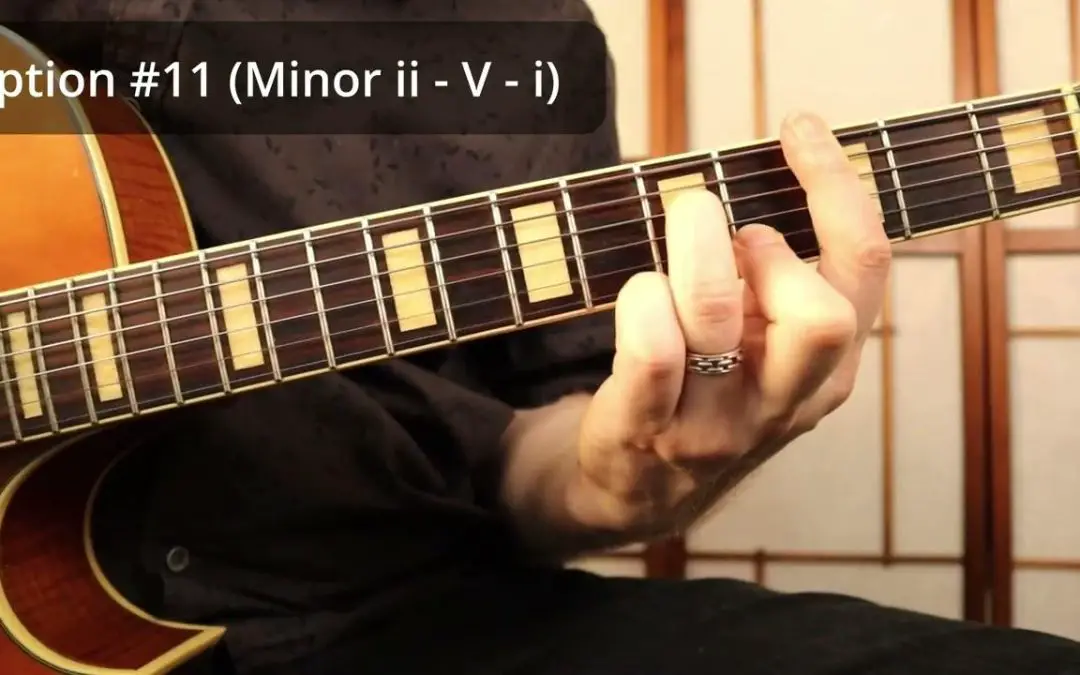Picture this: you’re jamming along to your favorite jazz tunes, feeling like a cool cat with your guitar in hand. But then, the dreaded 2-5-1 progression comes along and suddenly you’re sweating more than a sinner in church. Fear not, my fellow guitar aficionados, for I am here to guide you through mastering the elusive 2-5-1 progression on jazz guitar. So grab your pick, tune those strings, and get ready to jazz it up like never before!
Contents
- 1 Understanding the Structure of the 2-5-1 Progression
- 2 The Role of the 2-5-1 Progression in Jazz Music
- 3 Techniques for Playing the 2-5-1 Progression on Guitar
- 4 Common Chord Voicings for Jazz Guitar
- 5 Navigating Chord Changes Smoothly in the 2-5-1 Progression
- 6 Incorporating Improvisation into the 2-5-1 Progression
- 7 Advanced Concepts and Extended Chords in the 2-5-1 Progression
- 8 FAQs
- 9 Ready to Jazz Up Your Chords?
Understanding the Structure of the 2-5-1 Progression
So, you asked for an explanation on the 2-5-1 progression, huh? Well, buckle up because we’re about to dive deep into the world of jazz theory! Trust me, by the end of this, you’ll be spouting off about ii-V-I progressions like a seasoned musician.
Alright, let’s break it down. The 2-5-1 progression is a staple in jazz and it’s important to understand the structure behind it. Here’s how it works:
- The 2 refers to the chord built on the second degree of the scale.
- The 5 is the chord built on the fifth degree of the scale.
- And finally, the 1 is the chord built on the first degree of the scale.
Put them together and you’ve got yourself a classic jazz cadence that has been used in countless tunes. It’s like the peanut butter and jelly of chord progressions – simple, yet oh so satisfying.
The Role of the 2-5-1 Progression in Jazz Music
So, you wanna talk about the 2-5-1 progression in jazz music, huh? Well buckle up, because we’re about to dive deep into this cornerstone of jazz harmony.
First things first, let’s break it down for the uninitiated. The 2-5-1 progression is a series of chords that show up time and time again in jazz standards. It’s like the secret sauce that gives jazz its smooth, sophisticated flavor. Picture this: you start on the second degree of the scale, move to the fifth degree, and then resolve to the tonic. It’s like a musical magicians’ trick – except instead of pulling a rabbit out of a hat, you’re pulling a killer chord progression out of thin air.
Why is the 2-5-1 progression so dang important in jazz? Well, for starters, it’s like the PB&J of jazz harmony. It’s versatile, reliable, and just plain tasty. Whether you’re jamming with a small combo or playing in a big band, the 2-5-1 progression is your go-to move for adding color and spice to your music.
Think of the 2-5-1 progression as the ultimate jazz cheat code. It’s like having a secret weapon in your musical arsenal that can elevate your playing from zero to hero in no time flat. So next time you’re noodling around on your instrument, remember to sprinkle in some 2-5-1 magic and watch your jazz chops soar to new heights.

Techniques for Playing the 2-5-1 Progression on Guitar
If you want to impress everyone at the next jam session with your guitar skills, mastering the 2-5-1 progression is key. This essential chord progression will have you sounding like a pro in no time!
Here are some techniques to help you navigate the 2-5-1 progression like a boss:
- **Learn your chords:** Make sure you know the basic major, minor, and dominant 7th chords like the back of your hand. Practice switching between them smoothly to build muscle memory.
- **Experiment with different voicings:** Don’t be afraid to shake things up by trying out different chord voicings. Playing the same old shapes can get boring, so get creative and find new ways to play the chords in the 2-5-1 progression.
- **Focus on your timing:** The key to a killer 2-5-1 progression is nailing the timing. Practice playing the chords in time with a metronome to ensure your rhythm is spot on.

Common Chord Voicings for Jazz Guitar
So you want to expand your jazz guitar chord voicing repertoire, huh? Well, you’ve come to the right place! Below are some common voicings that will have you swinging like a pro in no time.
First up, we have the timeless Drop 2 voicing. This voicing involves taking the second note from the top of a four-note chord and dropping it down an octave. It’s like playing musical Tetris, but way more fun!
Next, we have the Shell Voicing, which consists of just the root and 7th of a chord. It’s like minimalist jazz – less is more, baby!
And let’s not forget about the Spread Voicing. This bad boy involves taking a four-note chord and spreading the notes out over multiple octaves. It’s like playing a game of hide and seek with your fingers!

So you want to master the art of ? Well, you’ve come to the right place, my friend. This jazz staple can be a bit tricky to navigate, but with a few tips and tricks up your sleeve, you’ll be slaying those changes like a pro in no time.
First things first, let’s break down the 2-5-1 progression for those who might not be familiar. In simple terms, it’s a sequence of chords that typically follows this pattern: a ii chord, a V chord, and then a I chord. For example, in the key of C major, your 2-5-1 progression would be Dm7 -> G7 -> Cmaj7. Got it? Good.
Now, onto the fun stuff. Here are some tips to help you navigate those chord changes like a boss:
- Practice, practice, practice: The key to mastering any progression is repetition. Spend some quality time with your instrument and really get comfortable with the changes.
- Focus on voice leading: Make sure that each note in your chord progression smoothly transitions to the next. This will help create a seamless and fluid sound.
- Use guide tones: The third and seventh of each chord are your best friends when it comes to navigating changes. Keep these tones in mind as you move from one chord to the next.
Incorporating Improvisation into the 2-5-1 Progression
Are you tired of playing the same old boring 2-5-1 progression in your jazz solos? Well, fear not, my fellow musicians! It’s time to shake things up and spice up your improvisation game by incorporating some improvisation techniques into your 2-5-1 progression.
One way to add some flair to your 2-5-1 progression is by using chromaticism. Instead of sticking to the traditional diatonic notes, throw in some chromatic passing tones to give your solo a jazzy edge. Experiment with sliding into notes from a half step above or below, and watch as your audience’s jaws drop in amazement.
Another fun way to jazz up your 2-5-1 progression is by using arpeggios. Instead of playing the standard seventh chords, try arpeggiating through the extended chord tones to add layers of complexity to your solo. Mix and match different arpeggio shapes and inversions to keep your audience on their toes and guessing what you’ll play next.
Don’t be afraid to experiment with rhythmic patterns in your improvisation. Break out of the boring 4/4 time signature and try incorporating odd time signatures like 5/4 or 7/8 into your 2-5-1 progression. Mix up your phrasing by playing around with syncopation and hemiolas to really keep your audience guessing and engaged in your solo. Remember, the key to great improvisation is to take risks and step outside of your comfort zone. So go forth, my friends, and let your creativity run wild in the world of the 2-5-1 progression!
Advanced Concepts and Extended Chords in the 2-5-1 Progression
So you think you’ve mastered the standard 2-5-1 progression, huh? Well, get ready to take your jazz chops to the next level with advanced concepts and extended chords!
One way to spice up your 2-5-1 progression is by adding in some fancy chord extensions. Instead of just playing basic triads, try throwing in some 7ths, 9ths, or even 13ths for that extra jazzy flair. Your audience will be so impressed they’ll think you’re the next jazz legend!
Another fun trick to try out is the use of tritone substitutions. Instead of sticking to the traditional ii-V-I progression, mix things up by substituting the V chord with a dominant 7th chord located a tritone away. It may sound complex, but trust me, your ears will thank you!
Don’t be afraid to experiment with altered chords as well. Add in some sharp 11ths, flat 9ths, or even altered dominants to keep your listeners on their toes. Jazz is all about pushing boundaries, so why not push some buttons while you’re at it?
FAQs
Can I play the 2-5-1 progression with just basic chords?
Absolutely! You can start with basic major and minor chords and gradually add in more complex voicings as you become more comfortable with the progression.
What are some common substitutions for the 2-5-1 progression?
Oh, there are plenty of substitutions you can use to spice up your playing! Try substituting a minor 7 chord for the dominant 7 or a minor 7b5 for the minor 7. Get creative and see what sounds best to your ear.
How can I improve my improvisation skills over the 2-5-1 progression?
Practice, practice, practice! Start by learning the arpeggios for each chord in the progression and then experiment with different scales and modes. The more you play around with it, the more comfortable you’ll become with improvising over the 2-5-1.
What are some common mistakes to avoid when playing the 2-5-1 progression?
One big mistake to avoid is neglecting rhythm! Make sure you’re paying attention to your timing and phrasing when playing the progression. Also, be mindful of your voicings and make sure they fit well within the context of the song.
How can I incorporate the 2-5-1 progression into my own compositions?
The possibilities are endless when it comes to incorporating the 2-5-1 progression into your own compositions! Try experimenting with different keys, tempos, and rhythms to see what works best for your style. Have fun exploring and see where the progression takes you!
Ready to Jazz Up Your Chords?
Now that you’ve mastered the 2-5-1 progression on jazz guitar, you’re officially one strum closer to being the smoothest cat in town. So grab your guitar, put on your coolest shades, and get ready to serenade the world with your newfound jazziness. Keep on strumming, you cool cat!



